(完整版)24G射频低噪声放大器毕业设计
24G射频双向功放电路设计

2.4G射频双向功放电路设计来源:互联网在两个或多个网络互连时,无线局域网的低功率与高频率限制了其覆盖范围,为了扩大覆盖范围,可以引入蜂窝或者微蜂窝的网络结构或者通过增大发射功率扩大覆盖半径等措施来实现。
前者实现成本较高,而后者则相对较便宜,且容易实现。
现有的产品基本上通信距离都比较小,而且实现双向收发的比较少.本文主要研究的是距离扩展射频前端的方案与硬件的实现,通过增大发射信号功率、放大接收信号提高灵敏度以及选择增益较大的天线来实现,同时实现了双向收发,最终成果可以直接应用于与IEEE802。
11b/g兼容的无线通信系统中。
双向功率放大器的设计双向功率放大器设计指标:工作频率:2400MXX~2483MXX最大输出功率:XX30dBm(1W)发射增益:≥27Db接收增益:≥14dB接收端噪声系数:XX 3。
5dB频率响应:XX±1dB输入端最小输入功率门限:XX—15dBm具有收发指示功能具有电源极性反接保护功能根据时分双工TDD的工作原理,收发是分开进行的,因此可以得出采用图1的功放整体框图。
图1、2.4GXX双向功放电路的总体框图功率检波器信号输入端接在RF信号输入通道上的定向耦合器上。
当无线收发器处在发射状态时,功率检波器检测到无线收发器发出的信号,产生开关切换信号控制RF开关打向发射PA通路,LNA电路被断开,双向功率放大器处在发射状态。
当无线收发器处在接收状态时,功率检波器由于定向耦合器的单方向性而基本没有输入信号,这时通过开关切换信号将RF开关切换到LNA通路,PA通路断开,此时双向功率放大器处在接收状态。
下面介绍重点部位的设计:发射功率放大(PA)电路发射功率放大电路的作用是将无线收发器输入功率放大以达到期望输出功率。
此处选择单片(MMIC)作为功率放大器件,并采用两级级联的方式来同时达到最大输出功率与增益的要求。
前级功率放大芯片选择RFMDXX的RF5189,该芯片主要应用在IEEE802.11b WLAN、2.4GXX IXX频段商用及消费类电子、无线局域网系统、扩频与MMDS系统等等.RF5189的增益可以通过VREG引脚电压控制,在本设计中VREG电压取XX3V,使RF5189具有最大增益。
(完整版)低频小信号功率放大_毕业设计_好!

实用低频功率放大器的设计摘要本课题介绍制作具有小信号放大能力的低频功率放大器,主要介绍其基本原理、内容、技术线路等。
本系统是基于(IC)NE5532,(IC)LM1875设计而成的一种低频小信号功率放大器,由直流稳压电源,电压放大级电路,功率放大级电路,带阻滤波电路及数据采集显示模块五部分组成。
其主要功能是将10Hz----50KHz的低频小信号放大,当输出功率大于5W时波形无明显失真,并将系统的输出功率,直流电源的供给功率和整机效率实时地显示出来。
本设计具有低功耗,性价比高,稳定性好,应用广泛等优点。
关键词:功率放大集成块NE5532 集成块LM1875 集成块AD736单片机AT89S52AbstractThis task introduce how to make one of bass frequency power amplifier, which can blow up puny signal, and the amplifier’s basic principle, content and the technology.This bass frequency power amplifier is based upon the Integrated block NE5532 and the Integrated block LM1875. It contains five segments such as the voltage-stabilized source, the voltage_ blowup circuit, the power-blowup circuit, the BEF circuit, the data_ collection and data-disposal circuit and so on.This bass frequency power amplifier’s mostly function is blow up the bass frequency puny signal, which has from 50Hz to 50KHz channel. The wave has no evident distortion, when the output-power has overed 5W. This design require display the system’s output-power, the DC’s purvey power and the whole enginery ’s efficiency momentarily .This design has a large number of advantages, such as lowness power, the good capability and the right price, the upstanding stability, the far-ranging application and so on.Keywords: Power Blowup (IC) NE5532 (IC)LM1875 (IC)AD736 MCU AT89S52目录摘要 (I)Abstract (II)目录.............................................................................................................. I II前言 (1)1、设计分析及技术指针 (2)1.1设计分析 (2)1.2设计技术指标 (2)2.系统设计方案 (3)2.1方案一 (3)2.2方案二 (4)3.方案设计 (5)3.1低频小信号功率放大器电路的框图 (5)3.2低频小信号功率放大器电路原理图 (5)3.3电路内部各框图的工作原理 (6)3.3.1 ±15V +5V稳压电源电路各框图的工作原理 (6)3.3.2 波形变换电路模块的工作原理 (7)3.3.3 前置运放电路模块的工作原理 (8)3.3.4 功放电路模块的工作原理 (8)3.3.5 滤波电路模块的工作原理 (9)3.3.6 数据采集电路模块的工作原理 (9)3.3.7 保护电路模块的工作原理 (10)4.各单元电路的设计 (11)4.1前置运放电路的设计 (12)4.1.1方案一:采用运算放大器构成的前置放大电路 (12)4.1.2方案二:采用专用前置放大器IC构成的前置放大电路 (14)4.2 功率放大器电路设计 (15)4.2.1采用分立元件构成的低频功率放大器电路 (16)4.2.2采用集成功放构成的低频功率放大器电路 (20)4.3 波形变换电路的设计 (22)4.4 滤波电路的设计 (24)4.5 数据采集中AC真有效值采集处理电路的设计 (26)4.6 稳压电源电路的设计 (29)4.6.1 220交流电源的变压电路的设计 (29)4.6.2 整流电路的设计 (30)4.6.3 滤波电路的设计 (31)4.7 显示电路的设计 (33)5.软件设计 (34)6.测试结果分析 (34)结论 (35)致谢 (35)参考文献 (36)附件 (37)前言低频功率放大器不仅仅是消费产品(音响)中不可缺少的设备,还广泛应用于控制系统和测量系统中。
低噪声放大器毕业设计_西安电子科技大学
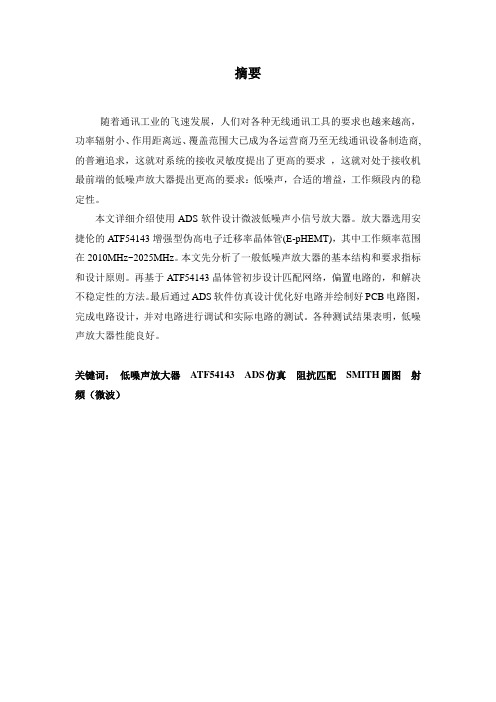
摘要随着通讯工业的飞速发展,人们对各种无线通讯工具的要求也越来越高,功率辐射小、作用距离远、覆盖范围大已成为各运营商乃至无线通讯设备制造商,的普遍追求,这就对系统的接收灵敏度提出了更高的要求,这就对处于接收机最前端的低噪声放大器提出更高的要求:低噪声,合适的增益,工作频段内的稳定性。
本文详细介绍使用ADS软件设计微波低噪声小信号放大器。
放大器选用安捷伦的ATF54143增强型伪高电子迁移率晶体管(E-pHEMT),其中工作频率范围在2010MHz~2025MHz。
本文先分析了一般低噪声放大器的基本结构和要求指标和设计原则。
再基于ATF54143晶体管初步设计匹配网络,偏置电路的,和解决不稳定性的方法。
最后通过ADS软件仿真设计优化好电路并绘制好PCB电路图,完成电路设计,并对电路进行调试和实际电路的测试。
各种测试结果表明,低噪声放大器性能良好。
关键词:低噪声放大器ATF54143ADS仿真阻抗匹配SMITH圆图射频(微波)AbstractWith the rapid development of communications industries, there is a variety of wireless communication tools have become more sophisticated requirements, small power radiation, the role of distance, large-scale coveragehas become the largest operator of wireless communications equipment as well as manufacturers, the general pursuit of this sensitivity of the system to receive a higher demand, which on most front-end receiver in the low-noise amplifier to higher requirements: low-noise, the appropriate gain, the stability of working frequency band.This paper describes the use of ADS software design of microwave low-noise small-signal amplifier. Selection of Agilent Technologies’s ATF-54143 amplifier transistor (E-pHEMT), Work in which frequency range 2010MHz ~ 2025MHz. This article first analyzes the general low-noise amplifier of the basic structure and requirements of indicators and design principles. Re-ATF54143 transistors based on the preliminary design of matching networks, bias circuits, and methods to resolve the instability. Finally, ADS software simulation through good circuit design optimization and a good PCB circuit diagram drawn to complete the circuit design and circuit debug and test the actual circuit. Various test results show that low-noise amplifier performance.Key words:low-noise amplifier ATF54143 ADS simulation SMITH Chart impedance matching RF (microwave)第一章绪论 (5)1.1 低噪声放大器 (5)1.1.1 概念 (5)1.1.2 主要功能 (5)1.1.3 主要应用领域 (6)1.2 低噪声放大器的研究现状 (6)1.3 本文的主要研究成果和内容安排 (7)第二章低噪声放大器的分析与研究 (9)2.1 低噪声放大器的基本结构 (9)2.2 低噪声放大器的基本指标 (9)2.2.1 噪声系数 (10)2.2.2 增益 (10)2.2.3 输入输出驻波比 (11)2.2.3 反射系数 (11)2.2.4 放大器的动态范围(IIP3) (11)2.3 低噪声放大器设计设计的基本原则 (12)2.3.1 低噪声放大管的选择原则 (12)2.3.2 输入输出匹配电路的设计原则 (12)第三章低噪声放大器的设计 (15)3.1 放大器设计的主要流程 (15)3.2 低噪声放大管的选择 (15)3.3 稳定性计算 (17)3.4 输入输出匹配电路电路设计 (18)3.5 偏置电路 (19)3.6 电路中需要注意的一些问题 (19)第四章ADS软件仿真设计及电路的最终实现 (21)4.1 ADS软件介绍 (21)4.2 ADS仿真设计 (23)4.2.1 S参数仿真 (23)4.2.2 SP模型仿真 (26)4.2.3 封装模型仿真 (39)4.3 ADS仿真设计结果分析 (46)第五章PCB板设计和最终电路的测试 (47)5.1 PCB板电路图 (47)5.1.1 Protel的介绍 (47)5.1.2 用Protel绘制PCB图 (47)5.2 电路焊接和测试结果 (49)第六章总结与展望 (52)6.1 本文总结 (52)6.2 不足与进一步的工作 (52)第七章结束语 (54)参考文献 (55)致谢 (56)附录A (57)第一章绪论1.1 低噪声放大器在无线通信系统中,为了提高接受信号的灵敏度,一般在接收机前端放置低噪声放大器用来提高增益并降低系统的噪声系数。
低噪声功率放大器设计

微波电子线路大作业——低噪声功率放大器设计班级:021013班学号:02011268姓名:低噪声放大器的设计一、设计要求:已知GaAs FET 在4 GHz 、50 Ω系统中的S 参数和噪声参量为S11=∠-60°,S21=∠81°,S12=∠26°,S22=∠-60°Fmin= dB Γout=∠100°RN=20 Ω设计一个低噪声放大器,要求噪声系数为2 dB ,并计算相应的最大增益。
若按单向化进行设计,则计算GT 的最大误差。
二、低噪声放大器设计原理及思路低噪声放大器功能概述低噪声放大器是射频/微波系统的一种必不可少的部件,它紧接接收机天线,放大天线从空中接收到的微弱信号。
低噪声放大器在对微弱信号放大的同时还会产生附加于扰信号,因此它的设计目标是低噪声,足够的增益,线性动态范围宽。
低噪声放大器影响整机的噪声系数和互调特性,分析如下 (1) 系统接收灵敏度: (2) 多个级连网络的总噪声系数放大器工作组态分类A 类放大器(导通角360度,最大理论效率50%)用于小信号、低噪声,通常是接收机前端放大器或功率放大器的前级放大。
B 类(导通角180度,最大理论效率%)和C 类(导通角小于180度,最大理论效率大于% )放大器电源效率高,愉出信号谐波成分高,需要有外部混合电路或滤波电路.由B 类和C 类放大器还可派生出D 类、E 类、P 类等放大器。
min114(dBm/Hz)NF 10log BW(MHz)/(dB)S S N =-+++32111212111n tot A A A A A AnF F F F FG G G G G G ---=++++放大器常用元器件①两端负阻的二极管器件变容二极管:参量放大隧道二极管:隧道效应耿氏二极管:转移电子碰撞雪崩渡越时间二极管:雪崩渡越时间特点:应用于放大器电路的早期器件,制造比较容易、便宜,但是两端口器件实现增益的相关电路价格确比较昂贵,且稳定性较差,调试工作困难。
基于ZigBee射频接收机的018μm CMOS24GHz低噪声放大器的设计
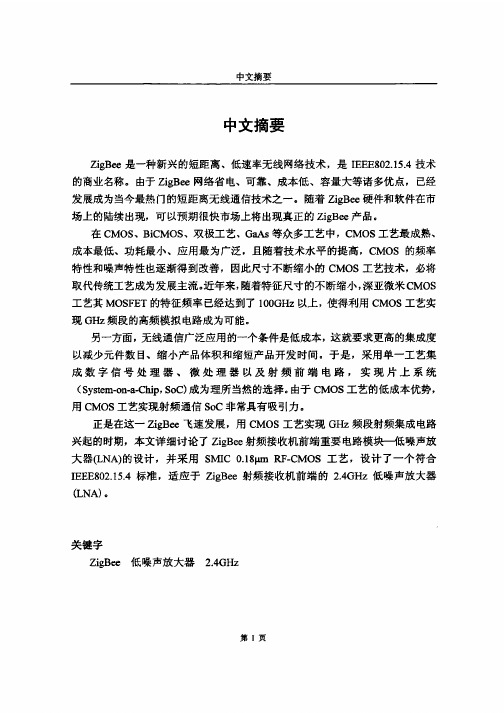
l o w e r N F , l a g e r g a i n a n d b e t t e r I I P 3 a t t h e l o w e r p o w e r d i s s i p a t i o n o f 5 m W a t t h e
s a m e t i m e , s o t h a t s a t i s f y i n g t h e Z i g B e e r e c e i v e r a p p i l c a t i o n s . Ke y w o r d : Z i g B e e L N A 2 . 4 G H z
t o a c c o m p l i s h R F c i r c u i t s p o s s i b l e .
O n t h e o t h e r h a n d , a c o n d i t i o n o f t h e e x t e n s i v e l y a p p l i c a t i o n o f w i r e l e s s c o m m u n i c a t i o n p r o d u c t s i s t h e l o w c o s t , s o i t ' s i m p o r t a n t t o i m p r o v e t h e i n t e g r a t i o n d e g r e e t o d e c r e a s e t h e c o m p o n e n t n u m b e r , t h e p r o d u c t p h y s i c a l v o l u m e a n d t h e p r o d u c t d e v e l o p m e n t t i m e . S o S o C ( S y s t e m - o n - a - C h i p ) b e c o m e s a n i n e v i t a b l e c h o i c e . B e c a u s e o f i t ' s l o w c o s t a d v a n t a g e , u s i n g t h e C M O S t e c h n o l o g y t o c a r y r o u t
一种低功耗2.4GHz低噪声放大器设计

59 1
是大 滤 波 电容 , , L 构 成 输 入 匹 配 网络 , 中 c 其
,
噪声系数如图 8 所示 , 0 7 B 达到了较好 为 .2d ,
的噪声 匹 配 。三 阶 交 调 测 试 如 图 9所 示 ,I 为 I P
C 本 文采 用 片 外 实 现 , 主 要 从 噪 声 指 标 和测 这
也呈感性 。由文献 [ ] 6 可知 I [ 与 I [ 。] m Z ] m Z。 的比 例 系数相 近 , 部 也就 满 足 了 匹 配 条 件 。对 于 Z。 虚 。 的实部 , 其大小与 c 呈反 比, 通过改变 M S的栅宽 O 从而改变 c 的值 , 来调节 R [ ] e Z 的大小。通常情
图 1 共 源 共栅 L A 原 理 图 N
项 目来源 : 基于传 输线频率选择器 的 C S硅基毫米波 压控 振荡 器研 究( Y 0 3 10 3 MO K Z4703 )
收稿 日期 :0 1 o — 4 2 1一 4 2 修改 日期 :0 1 o — 5 2 1 一 5 2
58 l
阻抗 :
n
可 以看出, 增加 c 也是付出了一定的代价 。为
使 R [ i = 0Q仍满足 , e z ] 5 必须增大源极 串联电感
+ s 表+
Z Z =
( 5 )
() 6
当满 足条件 式 ( )式 ( ) 电路 将 同时 达 到功 6 、 7时 率 匹配 和噪声 匹配 :
关键 词 :M S低噪声放大器; C O; 噪声匹配; 低功耗;
中图分 类号 :N T 4
文献标 识码 : A
文章 编号 :0 5 99 (01 o — 5 7 0 10 — 40 2 1 )5 0 1 — 4
(完整版)24G射频低噪声放大器毕业设计论文
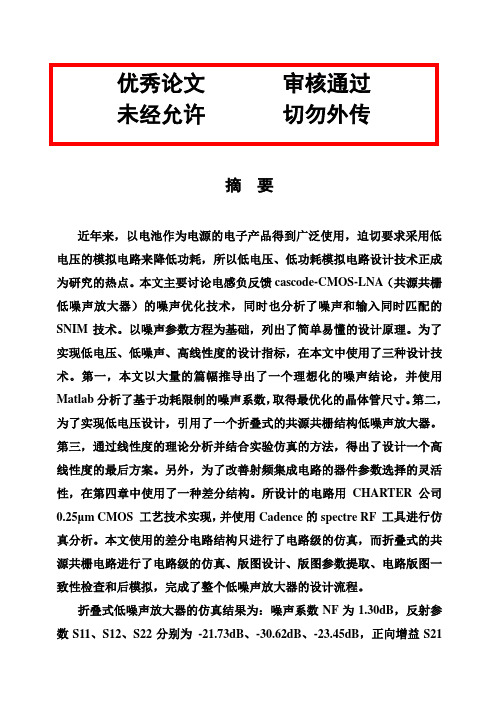
摘要近年来,以电池作为电源的电子产品得到广泛使用,迫切要求采用低电压的模拟电路来降低功耗,所以低电压、低功耗模拟电路设计技术正成为研究的热点。
本文主要讨论电感负反馈cascode-CMOS-LNA(共源共栅低噪声放大器)的噪声优化技术,同时也分析了噪声和输入同时匹配的SNIM技术。
以噪声参数方程为基础,列出了简单易懂的设计原理。
为了实现低电压、低噪声、高线性度的设计指标,在本文中使用了三种设计技术。
第一,本文以大量的篇幅推导出了一个理想化的噪声结论,并使用Matlab分析了基于功耗限制的噪声系数,取得最优化的晶体管尺寸。
第二,为了实现低电压设计,引用了一个折叠式的共源共栅结构低噪声放大器。
第三,通过线性度的理论分析并结合实验仿真的方法,得出了设计一个高线性度的最后方案。
另外,为了改善射频集成电路的器件参数选择的灵活性,在第四章中使用了一种差分结构。
所设计的电路用CHARTER公司0.25μm CMOS 工艺技术实现,并使用Cadence的spectre RF 工具进行仿真分析。
本文使用的差分电路结构只进行了电路级的仿真,而折叠式的共源共栅电路进行了电路级的仿真、版图设计、版图参数提取、电路版图一致性检查和后模拟,完成了整个低噪声放大器的设计流程。
折叠式低噪声放大器的仿真结果为:噪声系数NF为1.30dB,反射参数S11、S12、S22分别为-21.73dB、-30.62dB、-23.45dB,正向增益S21为14.27dB,1dB压缩点为-12.8dBm,三阶交调点IIP3 为0.58dBm。
整个电路工作在1V电源下,消耗的电流为8.19mA,总的功耗为8.19mW。
所有仿真的技术指标达到设计要求。
关键字:低噪声放大器;噪声系数;低电压、低功耗;共源共栅;噪声匹配ABSTRACTIn recent years, electronics with battery supply are widely used, which cries for adopting low voltage analog circuits to reduce power consumption, so low voltage, low power analog circuit design techniques are becoming research techniques for inductively degenerated cascode CMOS low-noise amplifiers (LNAs) with on-chip inductors. And it reviews and analyzes simultaneous noise and input matching techniques (SNIM). Based on the noise parameter equations, this paper provides clear understanding of the design principle. In order to achieve low-voltage, low noise, specifications, in this paper by three design technology. Firstly, using Matlab tool analyzes noise figure based on power-constrained, and obtain the optimum transistor size. Secondly, design a folded-cascode-type LNA to reduce the power supper. Third, through theoretical analysis of Linear and combine simulation methods, I obtain a final design of a the other side, in order to improve the radio frequency integrated circuit device parameters of flexibility, this paper presents a difference in the structure in the fourth chapter. The proposed circuit design is realized using csm25RF 0.25μm CMOS technology, simulated with Cadence specter RF.Based on csm25RF 0.25μm CMOS technology, the resulting differential LNA achieves 1.32dB noise figure, -20.65dB S11, -24dB S22, -30.27 S12, 14 dB S21. The LNA's 1-dB compression point is -13.3dBm, and IIP3 is -0.79dBm, with the core circuit consuming 8.1mA from a 1V power supply.Key words:low-noise amplifier (LNA);noise figure;low voltage low power;cascode;noise matching目录第一章绪论 (1)1.1课题背景 (1)1.2研究现状及存在的问题 (2)1.3本论文主要工作 (3)1.4论文内容安排 (3)第二章射频电路噪声理论和线性度分析 (4)2.1噪声理论 (4)2.1.1 噪声的表示方法 (4)2.1.2 本文研究的器件噪声类型 (5)2.1.2.1 热噪声 (5)2.1.2.2 MOS噪声模型 (6)2.1.3 两端口网络噪声理论 (7)2.1.4 多级及联网络噪声系数计算 (9)2.2MOSFET两端口网络噪声参数的理论分析 (10)2.3降低噪声系数的一般措施 (13)2.4MOS LNA线性度分析 (14)2.4.1 1dB压缩点 (14)2.4.2 三阶输入交调点IIP3 (16)2.4.3 多级及联网络线性度表示方法(起最重要作用的线性级) (17)2.5小结 (18)第三章 CMOS低噪声放大器的设计理论推导 (20)3.1LNA设计指标 (20)3.1.1 噪声系数 (20)3.1.2 增益 (20)3.1.3 线性度 (20)3.1.4 输入输出匹配 (21)3.1.5 输入输出隔离 (21)3.1.6 电路功耗 (21)3.1.7 稳定性 (21)3.2CMOS LNA拓扑结构分析 (21)3.2.1 基本结构及比较 (21)3.2.2 源极去耦与噪声、输入同时匹配(SNIM)的设计 (22)3.2.3 共源共栅电路结构(cascode) (27)3.2.4 功率限制的单端分析—获得最佳化的宽长比 (29)3.3其它改进型电路比较 (31)3.4偏置电路的设计 (33)3.5 CASCODE设计结论 (34)第四章 2.4GHZ LNA电路设计 (35)4.1工艺库的元器件 (35)4.2差分CASCODE电路 (35)4.2.1 差分电路的设计 (35)4.2.2 差分电路的电路极仿真 (37)4.3单端CASCODE电路 (39)4.3.1 单端电路的设计 (39)4.3.2 单端电路的电路级仿真 (42)4.3.3 单端电路的版图设计、提取及后模拟 (45)4.4电路级仿真和后模拟仿真总结 (48)4.5与其它电路的比较 (49)结束语 (50)致谢 (51)参考文献 (52)附录A 二端口网络的噪声理论补充 (53)附录B S参数与反射系数 (55)B.1双端口网络S参数 (55)B.2反射系数与S参数的关系 (56)B.3其它参数与S参数的关系 (57)附录C 电感源极负反馈共源电路噪声推导 (58)附录D MATLAB程序 (62)第一章绪论1.1 课题背景在最近的十多年来,迅猛发展的射频无线通信技术被广泛地应用于当今社会的各个领域中,如:高速语音来,第3代移动通信(3G)、高速无线互联网、Bluetooth以及利用MPEG标准实现无线视频图像传输的卫星电视服务等技术是日新月异,无线通讯技术得到了飞速发展,预计到2010年,无线通信用户将达到10亿人[1],并超过有线通信用户。
低噪声放大器的设计制作与调试报告

微波电路 CAD 射频实验报告姓名班级学号实验一低噪声放大器的设计制作与调试一、实验目的(一)了解低噪声放大器的工作原理及设计方法。
(二)学习使用ADS软件进行微波有源电路的设计,优化,仿真。
(三)掌握低噪声放大器的制作及调试方法。
二、实验内容(一)了解微波低噪声放大器的工作原理。
(二)使用ADS软件设计一个低噪声放大器,并对其参数进行优化、仿真。
(三)根据软件设计的结果绘制电路版图,并加工成电路板。
(四)对加工好的电路进行调试,使其满足设计要求。
三、实验步骤及实验结果(一)晶体管直流工作点扫描1、启动软件后建立新的工程文件并打开原理图设计窗口。
2、选择File——New Design…进入下面的对话框;3、在下面选择BJT_curve_tracer,在上面给新建的Design命名,这里命名为BJT Curve;4、在新的Design中,会有系统预先设置好的组件和控件;5、如何在Design中加入晶体管;点击,打开元件库;6、选择需要的晶体管,可以点击查询;7、对41511的查询结果如下,可以看到里面有这种晶体管的不同的模型;8、以sp为开头的是S参数模型,这种模型不能用来做直流工作点的扫描;9、选择pb开头的模型,切换到Design窗口,放入晶体管,按Esc键终止当前操作。
10对41511的查询结果如下,可以看到里面有这种晶体管的不同的模型11、以sp为开头的是S参数模型,这种模型不能用来做直流工作点的扫描12、选择pb开头的模型,切换到Design窗口,放入晶体管,按Esc键终止当前操作。
图1 BJT Curve仿真原理图13、按Simulate键,开始仿真,这时会弹出一个窗口,该窗口会现实仿真或者优化的过程信息。
如果出现错误,里面会给出出错信息,应该注意查看。
14、仿真结束,弹出结果窗口,如下页图。
注意关闭的时候要保存为适宜的名字。
另外图中的Marker是可以用鼠标拖动的。
由于采用的是ADS的设计模板,所以这里的数据显示都已经设置好了。
一种射频宽带低噪声放大器的设计
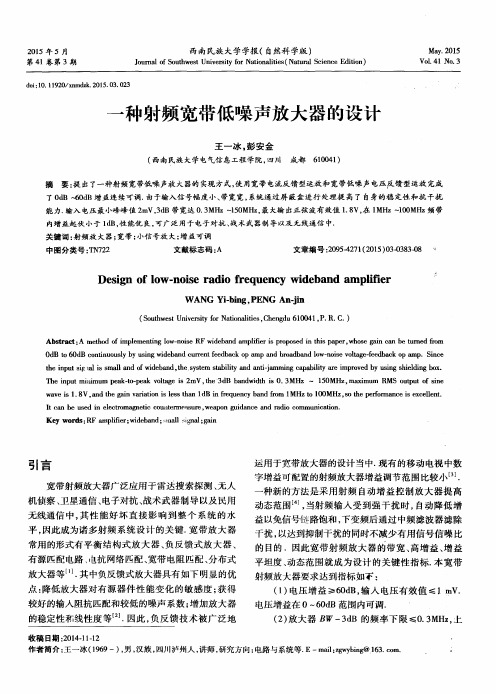
Ma y . 2 0 1 5
Vo 1 . 4 1 No . 3
第4 l卷 第 3期
d o i : 1 0 .1 1 9 2 0 /x n md z k . 2 0 1 5 . 03 . 0 2 3
一
种射频宽带低噪 声放大 器的设计
王一冰 。 彭 安金
( 西 南民族 大学电气信 息工程 学院, 四川 成都 6 1 0 0 4 1 )
Th e i n p ut mi a i mum pe a l 【 一 o— t p e a k v o l t a g e i s 2mV , he t 3d B b nd a wi dt h i s 0. 3M Hz ~ 1 5 0M Hz, ma x i mu m RMS o ut pu t f o s i ne
Ke y wo r d s: RF m p a l i i f e r ; id w e b n d; a -  ̄ ma l s ; g n a l ; g a i n
引 言
宽带 射频 放 大器 广泛 应用 于 雷达 搜索 探 测 、 无人 机 侦察 、 卫 星通 信 、 电子对 抗 、 战术 武 器制 导 以及 民用
De s i g n o f l o w— no i s e r a d i o f r e q u e nc y wi d e ba n d a mp l i ie f r
WA NG Yi - b i n g , P E NG An - j i n
( S o u t h w e s t U n i v e s , C b e n g d u 6 1 0 0 4 1 , P . R . C . )
I t Ca n b e us e d i n e l e c t r o ma g ne t i c C O ml t e r mca . s u r e, we a po n g ui d a nc e nd a r a di o c o mm u ic n a t i o n.
射频低噪声放大器的设计
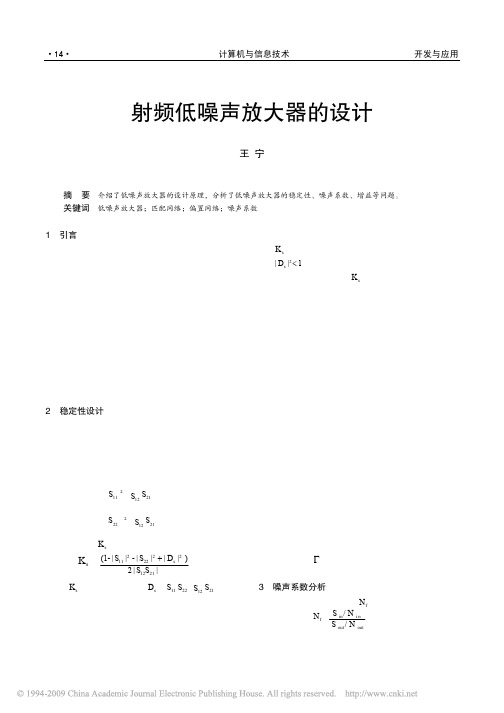
F = Fmin +
4R n | Γs − Γopt |2 (1− | Γs | ) | 1 + Γopt |
2 2
=F
min
+N
| Γs − Γopt |2 1− | Γs |2
(6)
式中
N=
4R n ; | 1 + Γopt |2
由式(6)可以看出,当器件的参数一定时,网络的噪声 系数F的大小可以完全由源反射系数 Γs 确定, 所以一般情况下 可以通过调整源反射系数 Γs 来改变噪声系数。在设计放大器 的输入匹配网络时,若使 Γs = Γopt ,即设计成最佳噪声匹配状 态,这时放大器的噪声系数就等于晶体管的最小噪声系数
Fmin 。
前面得到的噪声系数公式只适用于单级,实际设计中往 往是多级放大对于多级放大器,其总的噪声系数 Fall 为:
5
匹配网络设计
在设计放大器时,一般有以下几种原则:一是以达到最
F -1 F -1 Fn -1 Fall = F1 + 2 + 3 +L+ G1 G1G 2 G1G 2 L G n −1
F1 = F2 =…= Fn = F
G1 = G 2 =…= G n = G
则(6)式可以利用级数求和得到下式:
式中
Fall =1+M M= F - 1 1 - 1/G
(8)
应的公式。对于不同的设计原则,相应的匹配网络的结构也 就不一样。实际的应用中三极管的输入共轭匹配的源反射系 数( Γs ) 和最小噪声源反射系数( Γopt ) 很少一致。因此, 必须找到一种折中的输入匹配方法来满足最佳噪声系数和最 佳输入反射回损的性能。 当由一个给定的噪声系数 F = Fi 来设 计 Γs 时,可由式(6) 可以推出等噪声系数圆方程,其方程
低噪声放大器的设计-射频课程设计

低噪声放大器的设计-射频课程设计射频设计报告低噪声放大器的设计目录1 前言 ........................................................................... ........................................ 1 2 低噪声放大器的主要技术指标 (1)2.1 工作频率与带宽 ........................................................................... ......... 1 2.2 噪声系数 ........................................................................... ..................... 2 2.3 增益 ........................................................................... ............................. 2 2.4 放大器的稳定性 ........................................................................... ......... 3 2.5 输入阻抗匹配 ........................................................................... ............. 3 2.6 端口驻波比和反射损耗 (3)3 低噪声放大器的设计指标 ........................................................................... .... 4 4 设计方案 ........................................................................... .. (5)4.1 直流分析及偏置电路的设计 ................................................................ 5 4.2 稳定性分析 ........................................................................... ................. 7 4.3 匹配网络设计 ........................................................................... ............. 9 4.4 最大增益的输出匹配 ..........................................................................12 4.5 匹配网络的实现 ........................................................................... ....... 16 4.6 版图的设计 ........................................................................... ............... 17 5. 学习心得 ........................................................................... ............................. 23 参考文献............................................................................ . (24)1 前言低噪声放大器(low noise amplifier,LNA)是射频接收机前端的重要组成部分。
一种新型2.4 GHz RF低噪声放大器的设计
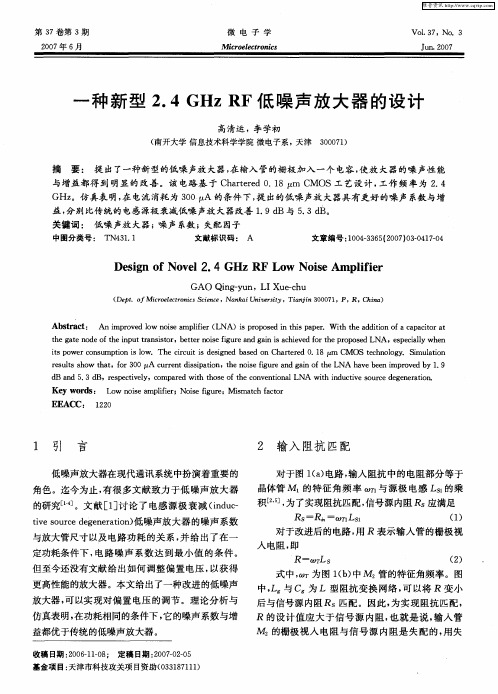
与放大管尺寸 以及 电路功耗 的关系 , 并给 出了在一
定功耗 条 件 下 , 路 噪 声 系 数 达 到 最 小 值 的条 件 。 电 但 至今还 没有 文献 给 出如 何 调 整 偏 置 电压 , 以获 得
对于改进后的电路 , R表示输入管的栅极视 用
G 。仿真表 明, 电流消耗 为 3 0 Hz 在 0 A的条件 下, 出的低噪声放大器具有更好的噪声 系数与增 提 益, 分别 比传 统 的 电感 源极 衰 减低噪 声放 大器 改善 19d . B与 53d . B。 关键词 : 低噪声放大器; 噪声 系数 ; 失配 因子
中图分类号 : TN4 1 1 3 . 文献标识码 : A 文章编号 :0 43 6 (0 7 0—4 70 1 0—3 5 2 0 )30 1—4
Ke o d y w r s: Lo n iea l ir w os mpi e ;Nos iu e f ief r :M imac a tr g s th fco
EEA CC: 1 2 20
I 引 言
低噪声放大器在现代通讯系统 中扮演着重要 的 角色。迄今为止 , 有很多文献致力 于低 噪声放大器 的研究[] 1 。文献 E - 4 ] 讨论 了电感 源极衰减 ( d c I i u— n
放大器 , 以实现对偏置 电压的调节 。理论分析与 可
仿真表明, 在功耗相 同的条件下 , 它的噪声系数与增
益都优于传统的低噪声放大器 。
收稿 日期 :0 61 —8 定 稿 日期 :0 70 —5 2 0 —10 ; 20 —20
R的设计值应大 于信号源 内阻 , 也就是说 , 输入 管
人 电阻 , 即
【最新版】低噪声放大器设计仿真及优化毕业设计
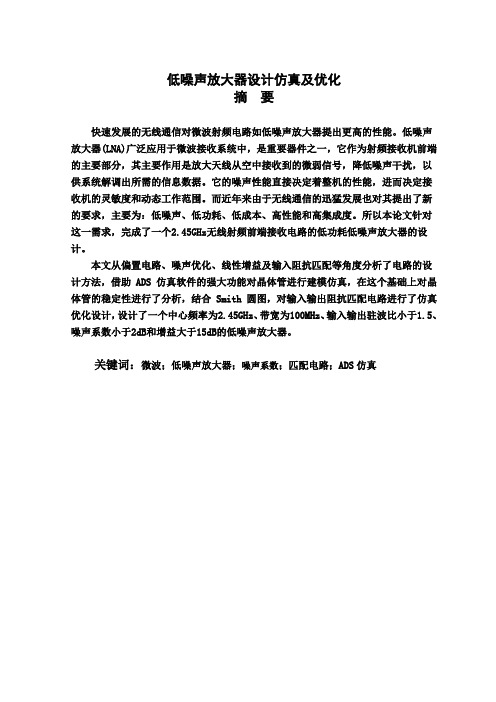
低噪声放大器设计仿真及优化摘要快速发展的无线通信对微波射频电路如低噪声放大器提出更高的性能。
低噪声放大器(LNA)广泛应用于微波接收系统中,是重要器件之一,它作为射频接收机前端的主要部分,其主要作用是放大天线从空中接收到的微弱信号,降低噪声干扰,以供系统解调出所需的信息数据。
它的噪声性能直接决定着整机的性能,进而决定接收机的灵敏度和动态工作范围。
而近年来由于无线通信的迅猛发展也对其提出了新的要求,主要为:低噪声、低功耗、低成本、高性能和高集成度。
所以本论文针对这一需求,完成了一个2.45GHz无线射频前端接收电路的低功耗低噪声放大器的设计。
本文从偏置电路、噪声优化、线性增益及输入阻抗匹配等角度分析了电路的设计方法,借助 ADS 仿真软件的强大功能对晶体管进行建模仿真,在这个基础上对晶体管的稳定性进行了分析,结合 Smith 圆图,对输入输出阻抗匹配电路进行了仿真优化设计,设计了一个中心频率为2.45GHz、带宽为100MHz、输入输出驻波比小于1.5、噪声系数小于2dB和增益大于15dB的低噪声放大器。
关键词:微波;低噪声放大器;噪声系数;匹配电路;ADS仿真ABSTRACTRapid growth of wireless data communications Microwave communication system receiver, as the main part of the RF front-end receiver, the function of the low noise amplifier is amplifying the faint signal which incepted from air by the antenna. It can reduce the noise jamming, so as to demodulate right information for the system. The noise performance of the LNA will affect the performance of the whole system directly, and then deciding the sensitivity and dynamic working scope of the receiver.From the aspect of bias circuit, noise optimization, linear gain, impedance match, and the design methodology for LNA is analyzed, This article carries on the modelling simulation with the aid of the ADS simulation software's powerful function to the transistor, the analysis in this foundation to transistor's stability, the simulation optimization design. a radio frequency power amplifier is designed, which 1.5, Noise coefficient less than 2dB and Wattandgain 15dB.Key Words:microwave;low-noise amplifier; noise figure; matching circuit; ADS simulation目录1引言 (1)1.1课题研究背景 (1)1.2低噪声放大器简介 (2)1.3低噪声放大器的发展现状 (2)1.4本课题的研究方法及主要工作 (3)2低噪声放大器理论综述 (5)2.1史密斯圆图 (5)2.2S参数 (6)2.3长线的阻抗匹配 (6)2.3.1微波源的共轭匹配 (7)2.3.2负载的匹配 (7)2.3.3匹配方法 (7)2.4微带线简介 (7)2.5偏置电路 (8)3低噪声放大器的基本指标 (9)3.1工作频带 (9)3.2带宽 (9)3.3噪声系数 (9)3.4增益 (10)3.5稳定性 (11)3.6端口驻波比和反射损耗 (12)4低噪声放大器设计仿真及优化 (13)4.1指标目标及设计流程 (13)4.2选取晶体管并仿真晶体管参数 (13)4.3晶体管S参数扫描 (15)4.4放大器的稳定性分析.......................................................... 错误!未定义书签。
宽带低噪声放大器设计毕业设计..

本科毕业设计学院专业年级姓名设计题目宽带低噪声放大器设计指导教师职称****年* 月* 日目录摘要 (1)Abstract. (1)1概述 (1)2低噪声放大器设计的原理 (2)2.1噪声系数 (2)2.2低噪声放大器的功率增益以及分配电压增益 (2)2.3端口驻波比 (3)2.4工作带宽与增益平坦度 (3)2.5动态范围以及压缩点 (3)2.6三阶截断点 (4)2.7低噪声放大器的稳定性 (4)3器件的选择 (4)3.1放大器的选择 (5)3.2放大器的介绍 (5)3.3电源的供电 (5)3.4选用器件的介绍 (5)4模拟电路设计 (5)4.1方案选择 (6)4.2模拟电路设计 (6)4.3电源电路 (6)5电路的调试 (8)5.1调试过程 (8)5.2测试结果 (8)5.3系统的改进措施 (10)6总结 (11)参考文献 (11)宽带低噪声放大器设计学生姓名:*** 学号:***********学院:专业:指导老师:职称:摘要:本文介绍了一个15V单电源供电的低噪声放大器设计,设计采用三级级联的方式。
该系统主要是宽带低噪声放大器,为了满足要求,采用了高速运算放大器μa741作为前两级放大,末级用CA3140作为功率放大电路。
测试结果表明,放大倍数为100倍,带宽有1MHz。
关键词:μa741;放大器;带宽;噪声系数The design of the low noise amplifier with broadbandAbstract: This article describes the design of a single 15V power supply and low noise amplifier. The system has three amplifier consisted ofμa741 and CA3140, which meet the requirements of broadband and low noise. Test results show that a amplifier with bandwidth 1MHz is 100 times.Keywords: μa741;amplifier;Bandwidth;noise figure1概述我们知道低噪声放大器是射频电路的重要组成部分,并且在有源滤波器等电子电路当中宽带低噪声放大器起着重要作用。
一种24GHz低噪声放大器的设计
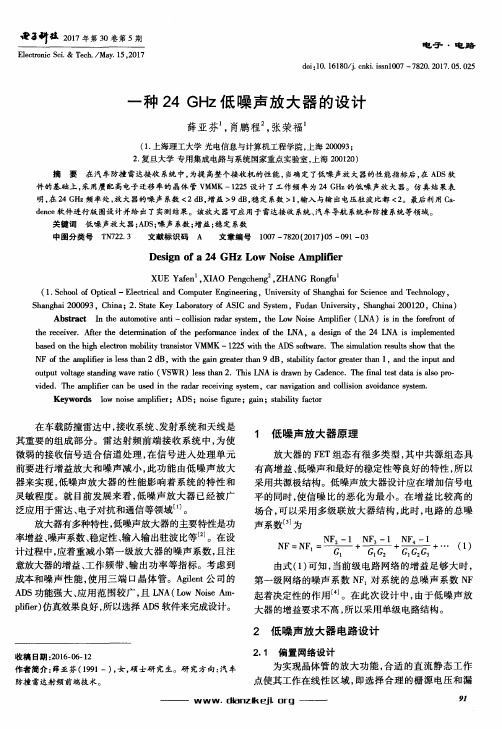
中图分 类号
De s i g n o f a 2 4 GH z Lo w No i s e Am p l i ie f r
XUE Ya f e n , XI AO P e n g c h e n g , ZHANG Ro n g f u
( 1 . S c h o o l o f O p t i c a l — E l e c t i r c a l a n d C o m p u t e r E n g i n e e r i n g , U n i v e r s i t y o f S h a n g h a i f o r S c i e n c e a n d T e c h n o l o g y , S h a n g h a i 2 0 0 0 9 3 , C h i n a ; 2 . S t a t e K e y L a b o r a t o r y o f A S I C a n d S y s t e m, F u d a n U n i v e r s i t y , S h a n g h a i 2 0 0 1 2 0 , C h i n a ) A b s t r a c t I n t h e a u t o m o t i v e a n t i —c o l l i s i o n r a d a r s y s t e m, t h e L o w N o i s e A m p l i i f e r ( L N A )i s i n t h e f o r e f r o n t o f
一种0.18μm2.4G CMOS低噪声放大器的设计

A s g f0 1 x . De i n o . 8 lm 2 4 GH z CM OS Lo No s w ie Am p iir lfe
ZHANG u l g, ia g J ni LIKah n n
( a n Un v r y X a e , 6 0 5 Chn ) Xime ie s , im n 3 1 0 , ia t
是L NA 的两 个 重 要 指 标 , 当然 这 两 个 指 标 还 要 与 功 耗 、 线
对于 C SL A 来说 , 常 要 求 S MO N 通 在 1 ~ 2 B O 0d 间 。如 果增 益 太 小 , N 不 能 将 微 弱 的输 入 信 号 ( 10 L A 一 4
~ 一
2. H z wiee sLAN p ia i 4G r ls a plc ton. Thede in i i ult d w ih T SM C sg ssm a e t 0.1 esgn ki u i 8 d i t sng AD S s t r . ofwa e The r s l h e u ts ows t tt op e . ha hepr os d INA squ t g q a iy W ih . i pu t e i pe n e npu a d ou pu r elm a c d wih ha ie hih u lt . t 1 8 V n t, h m da c s ofi t n t taew l t he t 5 O n.Thegan r a he o 1 .1 d wih 0.6 i e c s t 5 5 B, t 2 dB ie fgur . nd po e o u pto s 7 W . nos i e A w rc ns m in i .9 m
- 1、下载文档前请自行甄别文档内容的完整性,平台不提供额外的编辑、内容补充、找答案等附加服务。
- 2、"仅部分预览"的文档,不可在线预览部分如存在完整性等问题,可反馈申请退款(可完整预览的文档不适用该条件!)。
- 3、如文档侵犯您的权益,请联系客服反馈,我们会尽快为您处理(人工客服工作时间:9:00-18:30)。
以下文档格式全部为word格式,下载后您可以任意修改编辑。
摘要近年来,以电池作为电源的电子产品得到广泛使用,迫切要求采用低电压的模拟电路来降低功耗,所以低电压、低功耗模拟电路设计技术正成为研究的热点。
本文主要讨论电感负反馈cascode-CMOS-LNA(共源共栅低噪声放大器)的噪声优化技术,同时也分析了噪声和输入同时匹配的SNIM技术。
以噪声参数方程为基础,列出了简单易懂的设计原理。
为了实现低电压、低噪声、高线性度的设计指标,在本文中使用了三种设计技术。
第一,本文以大量的篇幅推导出了一个理想化的噪声结论,并使用Matlab分析了基于功耗限制的噪声系数,取得最优化的晶体管尺寸。
第二,为了实现低电压设计,引用了一个折叠式的共源共栅结构低噪声放大器。
第三,通过线性度的理论分析并结合实验仿真的方法,得出了设计一个高线性度的最后方案。
另外,为了改善射频集成电路的器件参数选择的灵活性,在第四章中使用了一种差分结构。
所设计的电路用CHARTER公司0.25μm CMOS 工艺技术实现,并使用Cadence的spectre RF 工具进行仿真分析。
本文使用的差分电路结构只进行了电路级的仿真,而折叠式的共源共栅电路进行了电路级的仿真、版图设计、版图参数提取、电路版图一致性检查和后模拟,完成了整个低噪声放大器的设计流程。
折叠式低噪声放大器的仿真结果为:噪声系数NF为1.30dB,反射参数S11、S12、S22分别为-21.73dB、-30.62dB、-23.45dB,正向增益S21为14.27dB,1dB压缩点为-12.8dBm,三阶交调点IIP3 为0.58dBm。
整个电路工作在1V电源下,消耗的电流为8.19mA,总的功耗为8.19mW。
所有仿真的技术指标达到设计要求。
关键字:低噪声放大器;噪声系数;低电压、低功耗;共源共栅;噪声匹配ABSTRACTIn recent years, electronics with battery supply are widely used, which cries for adopting low voltage analog circuits to reduce power consumption, so low voltage, low power analog circuit design techniques are becoming research techniques for inductively degenerated cascode CMOS low-noise amplifiers (LNAs) with on-chip inductors. And it reviews and analyzes simultaneous noise and input matching techniques (SNIM). Based on the noise parameter equations, this paper provides clear understanding of the design principle. In order to achieve low-voltage, low noise, specifications, in this paper by three design technology. Firstly, using Matlab tool analyzes noise figure based on power-constrained, and obtain the optimum transistor size. Secondly, design a folded-cascode-type LNA to reduce the power supper. Third, through theoretical analysis of Linear and combine simulation methods, I obtain a final design of a the other side, in order to improve the radio frequency integrated circuit device parameters of flexibility, this paper presents a difference in the structure in the fourth chapter. The proposed circuit design is realized using csm25RF 0.25μm CMOS technology, simulated with Cadence specter RF.Based on csm25RF 0.25μm CMOS technology, the resulting differential LNA achieves 1.32dB noise figure, -20.65dB S11, -24dB S22, -30.27 S12, 14 dB S21. The LNA's 1-dB compression point is -13.3dBm, and IIP3 is -0.79dBm, with the core circuit consuming 8.1mA from a 1V power supply.Key words:low-noise amplifier (LNA);noise figure;low voltage low power;cascode;noise matching目录第一章绪论 (1)1.1课题背景 (1)1.2研究现状及存在的问题 (2)1.3本论文主要工作 (3)1.4论文内容安排 (3)第二章射频电路噪声理论和线性度分析 (4)2.1噪声理论 (4)2.1.1 噪声的表示方法 (4)2.1.2 本文研究的器件噪声类型 (5)2.1.2.1 热噪声 (5)2.1.2.2 MOS噪声模型 (6)2.1.3 两端口网络噪声理论 (7)2.1.4 多级及联网络噪声系数计算 (9)2.2MOSFET两端口网络噪声参数的理论分析 (10)2.3降低噪声系数的一般措施 (13)2.4MOS LNA线性度分析 (14)2.4.1 1dB压缩点 (14)2.4.2 三阶输入交调点IIP3 (16)2.4.3 多级及联网络线性度表示方法(起最重要作用的线性级) (17)2.5小结 (18)第三章 CMOS低噪声放大器的设计理论推导 (20)3.1LNA设计指标 (20)3.1.1 噪声系数 (20)3.1.2 增益 (20)3.1.3 线性度 (20)3.1.4 输入输出匹配 (21)3.1.5 输入输出隔离 (21)3.1.6 电路功耗 (21)3.1.7 稳定性 (21)3.2CMOS LNA拓扑结构分析 (21)3.2.1 基本结构及比较 (21)3.2.2 源极去耦与噪声、输入同时匹配(SNIM)的设计 (22)3.2.3 共源共栅电路结构(cascode) (27)3.2.4 功率限制的单端分析—获得最佳化的宽长比 (29)3.3其它改进型电路比较 (31)3.4偏置电路的设计 (33)3.5 CASCODE设计结论 (34)第四章 2.4GHZ LNA电路设计 (35)4.1工艺库的元器件 (35)4.2差分CASCODE电路 (35)4.2.1 差分电路的设计 (35)4.2.2 差分电路的电路极仿真 (37)4.3单端CASCODE电路 (39)4.3.1 单端电路的设计 (39)4.3.2 单端电路的电路级仿真 (42)4.3.3 单端电路的版图设计、提取及后模拟 (45)4.4电路级仿真和后模拟仿真总结 (48)4.5与其它电路的比较 (49)结束语 (50)致谢 (51)参考文献 (52)附录A 二端口网络的噪声理论补充 (53)附录B S参数与反射系数 (55)B.1双端口网络S参数 (55)B.2反射系数与S参数的关系 (56)B.3其它参数与S参数的关系 (57)附录C 电感源极负反馈共源电路噪声推导 (58)附录D MATLAB程序 (62)第一章绪论1.1 课题背景在最近的十多年来,迅猛发展的射频无线通信技术被广泛地应用于当今社会的各个领域中,如:高速语音来,第3代移动通信(3G)、高速无线互联网、Bluetooth以及利用MPEG标准实现无线视频图像传输的卫星电视服务等技术是日新月异,无线通讯技术得到了飞速发展,预计到2010年,无线通信用户将达到10亿人[1],并超过有线通信用户。
这种潜在的市场造成了对射频集成电路的巨大需求。
原来的混合电路由于不能满足低成本、低功耗和高集成度的要求,而必然要被集成度越来越高的集成电路所取代,并最终形成单片射频收发机芯片。
典型的射频收发设备除了对功耗、速度、成品率等性能的要求外,还要考虑噪声、线性范围、增益等指标。
在硅CMOS,BiCMOS、双极工艺、GaAs MESFET,异质结双极晶体管(HBT),GeSi器件等众多工艺中,虽然硅CMOS的高频性能和噪声性能不是最好的,但是由于它的工艺最为成熟、成本最低、功耗最小、应用也最为广泛,且随着工艺水平的不断提高,硅CMOS的频率特性和噪声特性正在逐渐得到了改善。
重要的是,只有采用硅CMOS工艺才能最终实现单片集成。
因此,CMOS射频集成电路是未来的发展趋势[1]。
近几十年来,世界各国的研究人员在CMOS射频集成电路的设计和制作方面进行了大量的研究和探索,使CMOS射频集成电路的性能不断得以改善。
乐观的估计,在最近几年里,CMOS射频集成电路将彻底改变无线通信的面貌。
射频接收机通常有四种结构:超外差结构、直接变频结构、宽中频变频结构、和低中频变频结构。
这四种结构各有优点和缺点,接收机的结构由系统指标决定,包括系统工作频率、接收机动态范围、功耗和集成度等。
图1-1所示为超外差接收机的系统框图。
这是较为常用的射频接收机结构。
一个完整的射频收发系统包括RF前端和基带处理部分,RF前端又称作接收器,它决定着整个系统的基本性能指标,如误码率、发射功率、信道的抗干扰能力等。
而低噪声放大器(LNA)是RF前端的最前端,它直接感应天线接收到的微弱信号,并对其放大,然后传递给后级进行处理,是整个接收通道最为关键的模块之一。
因此,本文主要研究2.4GHz LAN在功耗限制和低电压条件下获得低噪声、高线性度的方法。
射频中频图1-1 超外差接收机的系统框图[2]1.2 研究现状及存在的问题近年来,射频集成电路(RF IC)的应用和研究得到了飞速的发展,CMOS射频集成电路的研究更是成为该领域的研究热点。
